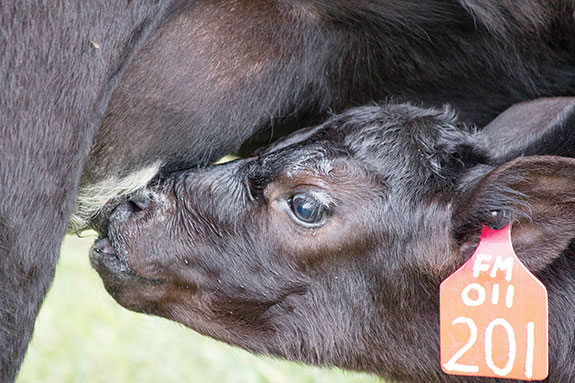With increasing input costs for the cow herd and rising market prices for feeder calves, calves born this year represent a significant financial investment for your operation and offer potential for even greater monetary returns.
In order to protect your investment, it’s crucial that newborn calves get off to the right start.
One of the most important things that happen at birth is the consumption of high-quality colostrum by the newborn calf.
A calf is born without any shield against disease and relies on the consumption of immunoglobulins (IgG) in the colostrum to protect itself from environmental pathogens and bacteria.
If the process of the calf consuming colostrum is compromised in any way, the future health of that calf and the overall productivity of the herd is put in jeopardy.
Calves that do not consume high-quality colostrum have low blood serum IgG concentrations.
Studies show that calves with inadequate serum IgG concentrations at 24 hours old are 3.2 to 9.5 times more likely to become sick and 5.4 times more likely to die before weaning.
These early calf losses can be costly to the cow-calf producer.
The benefits of the calf consuming high-quality colostrum within the first few hours after birth extend throughout the calf’s life.
On the steer side, research from the University of Nebraska shows that the likelihood of a carcass revealing respiratory lesions at the packing plant as a result of significant respiratory illness is greatly decreased if the calf received the proper quantity of quality antibodies through colostrum at birth.

For optimal results, a calf must consume at least 10 percent of its bodyweight in colostrum as soon as possible after birth.
Its ability to absorb immunoglobulins from colostrum begins to diminish almost immediately, reducing by half at 12 hours, and the calf completely loses the ability to absorb immunoglobulins at 24 hours.
A number of factors – from body condition to environment and calving ease to cow age – can influence the quality of colostrum available to the calf.
If you think colostrum quality could be impacted in any way, it is advisable to consider a colostrum replacer to ensure protection is provided to your calf crop from the start.
Here’s a look at situations that could impact the quality of colostrum available to newborn calves.
Body condition scores below 6
Nutrition plays a direct role in the production of colostrum. Cows with body condition scores (BCS) below six, on a nine-point scale, may not have received enough energy, protein, minerals and vitamins during the gestation period and, therefore, the ability to produce quality colostrum is reduced.
University research underscores this, showing that as BCS decreases so does the amount and concentration of immunoglobulins available to the calf through colostrum.
Difficult calving
Calves that experience difficult births may be slow to stand and nurse. Research from Oklahoma State University shows that calves born with no assistance stood and nursed within 40 minutes after birth and had a higher immunoglobulin concentration at 24 hours.
Meanwhile, calves that required assistance took more than an hour to stand and had a significantly lower immunoglobulin concentration.
Harsh winter weather
The weather is always an unknown factor, but harsh weather conditions can cause cold stress.
Calves that experience cold stress may be less likely to get up and nurse, while cold-stressed cows have reduced potential of providing high-quality colostrum.
First-calf heifers
Colostrum quality and quantity may be lower in first-calf heifers. Keep this in mind if you are calving in a large number of first-calf heifers this year.
First-calf heifers may also lack the “mothering instinct” and will not allow the calf to immediately suckle – or may reject the calf altogether. You may want to consider feeding a colostrum replacer to all calves born from these animals as a precautionary measure.
Summary
If you are faced with any of these situations this year, you may want to consider investing in a colostrum replacer to protect the future of your herd.
Calves born from underconditioned cows, through difficult births, during harsh weather or from first-calf heifers may not receive the protection they require.
A colostrum replacer is an insurance policy that all calves are protected from the start. ![]()
For more information, contact Dr. Tom Earleywine or call (608) 206-7264.
References omitted but are available upon request. Click here to email an editor.
PHOTOS
TOP: A number of factors, from body condition to environment and calving ease to cow age, can influence the quality of colostrum available to the calf. Photo courtesy of Land O’Lakes.
BOTTOM: A calf must consume at least 10 percent of its bodyweight in colostrum as soon as possible after birth. Photo courtesy of Progressive Cattleman staff.
Tom Earleywine
Director of Nutritional Services
Land O’Lakes Animal Milk Products
Criteria for choosing a colostrum replacer
A few options exist to replace or supplement the colostrum provided by the cow to a newborn calf. Here is a brief list of things to consider when deciding which might be the best option for your operation:
- Look for colostrum replacers that have been licensed by the USDA.
- Evaluate fat content of the colostrum replacer. High-quality colostrum contains 24 to 32 percent solids and has a fat content of 6.7 percent. A colostrum replacer should be at least 20 percent colostral fat.
- A colostrum replacement should contain at least 100 grams of actual IgG (not just globulin protein) per dose.
- Consider if the colostrum replacer requires one dose or multiple doses.
- Ask to see research to support the company’s product.
- Verify if the immunoglobulins in the colostrum are from actual colostrum or from alternative sources such as blood or serum.
- The cost will be $25 to $45 per dose and you get what you pay for in quantity and quality of the IgG in the product; dried USDA-licensed colostrum with high IgG levels will cost more.








